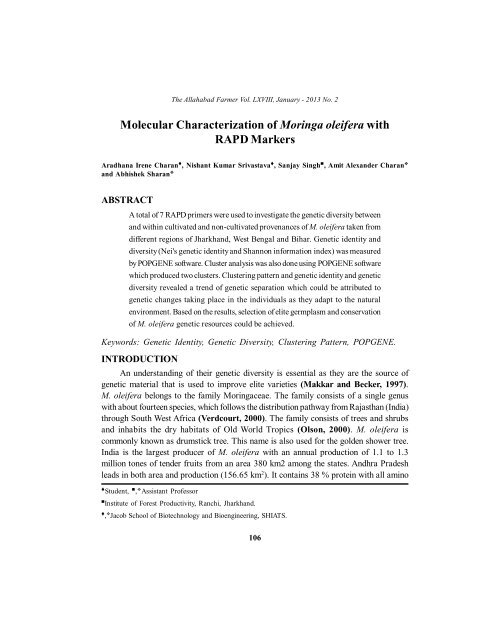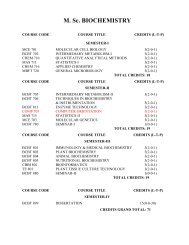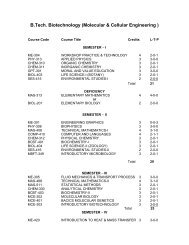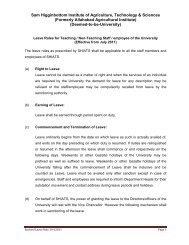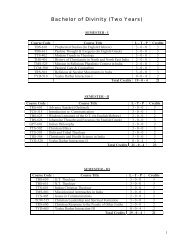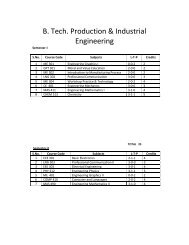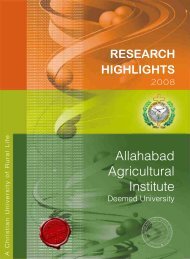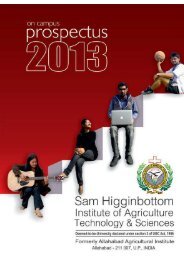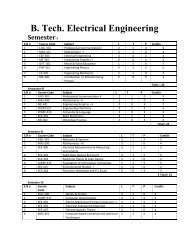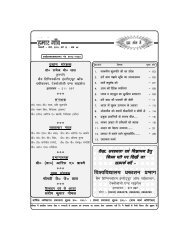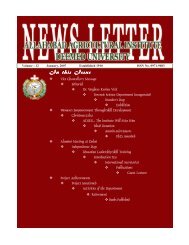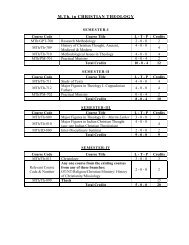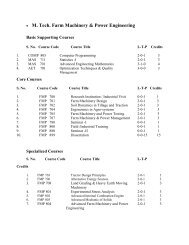The Allahabad Farmer Vol. LXVIII, January - 2013 No. 2Molecular Characterization <strong>of</strong> Mor<strong>in</strong>ga oleifera withRAPD MarkersAradhana Irene Charan , Nishant Kumar Srivastava , Sanjay S<strong>in</strong>gh • , Amit Alexander Charan and Abhishek Sharan ABSTRACTA total <strong>of</strong> 7 RAPD primers were used to <strong>in</strong>vestigate the genetic diversity betweenand with<strong>in</strong> cultivated and non-cultivated provenances <strong>of</strong> M. oleifera taken fromdifferent regions <strong>of</strong> Jharkhand, West Bengal and Bihar. Genetic identity anddiversity (Nei's genetic identity and Shannon <strong>in</strong>formation <strong>in</strong>dex) was measuredby POPGENE s<strong>of</strong>tware. Cluster analysis was also done us<strong>in</strong>g POPGENE s<strong>of</strong>twarewhich produced two clusters. Cluster<strong>in</strong>g pattern and genetic identity and geneticdiversity revealed a trend <strong>of</strong> genetic separation which could be attributed togenetic changes tak<strong>in</strong>g place <strong>in</strong> the <strong>in</strong>dividuals as they adapt to the naturalenvironment. Based on the results, selection <strong>of</strong> elite germplasm and conservation<strong>of</strong> M. oleifera genetic resources could be achieved.Keywords: Genetic Identity, Genetic Diversity, Cluster<strong>in</strong>g Pattern, POPGENE.INTRODUCTIONAn understand<strong>in</strong>g <strong>of</strong> their genetic diversity is essential as they are the source <strong>of</strong>genetic material that is used to improve elite varieties (Makkar and Becker, 1997).M. oleifera belongs to the family Mor<strong>in</strong>gaceae. The family consists <strong>of</strong> a s<strong>in</strong>gle genuswith about fourteen species, which follows the distribution pathway from Rajasthan (India)through South West Africa (Verdcourt, 2000). The family consists <strong>of</strong> trees and shrubsand <strong>in</strong>habits the dry habitats <strong>of</strong> Old World Tropics (Olson, 2000). M. oleifera iscommonly known as drumstick tree. This name is also used for the golden shower tree.India is the largest producer <strong>of</strong> M. oleifera with an annual production <strong>of</strong> 1.1 to 1.3million tones <strong>of</strong> tender fruits from an area 380 km2 among the states. Andhra Pradeshleads <strong>in</strong> both area and production (156.65 km 2 ). It conta<strong>in</strong>s 38 % prote<strong>in</strong> with all am<strong>in</strong>oStudent, • , Assistant Pr<strong>of</strong>essor•Institute <strong>of</strong> Forest Productivity, Ranchi, Jharkhand., Jacob School <strong>of</strong> Biotechnology and Bioeng<strong>in</strong>eer<strong>in</strong>g, SHIATS.106
Aradhana Irene Charan, Nishant Kumar Srivastava, Sanjay S<strong>in</strong>gh, Amit Alexander Charanand Abhishek Sharanacids, mak<strong>in</strong>g it a richer source <strong>of</strong> prote<strong>in</strong>s compared to other vegetables. The drumsticktree <strong>in</strong> fact has the highest prote<strong>in</strong> ratio <strong>of</strong> any plant on earth, with calcium content <strong>of</strong> theleaves be<strong>in</strong>g 297 mg per 100 g <strong>of</strong> leaves. 100 g <strong>of</strong> freshly cooked drumstick leavesprovide for 75 % <strong>of</strong> iron and 50 % <strong>of</strong> prote<strong>in</strong>s required by a grow<strong>in</strong>g child.MATERIALS AND METHODFresh leaves <strong>of</strong> M. oleifera were collected from Germplasm Bank established atNational Bureau <strong>of</strong> Plant Genetic Resources (NBPGR), Ranchi, which conta<strong>in</strong>s accession<strong>of</strong> drumstick plants which were collected from different locations <strong>of</strong> Jharkhand. Extraction<strong>of</strong> DNA <strong>in</strong> M. oleifera was done by (Doyle and Doyle, 1990), with some modification<strong>in</strong> the proc<strong>edu</strong>re, as M. oleifera conta<strong>in</strong>s some phenolic compounds which causestick<strong>in</strong>ess <strong>in</strong> the sample and make it difficult to isolate the DNA . So, <strong>in</strong> context withabove an additional step is added, which uses wash buffer conta<strong>in</strong><strong>in</strong>g 0.1% PVP and4% - Mercaptoethanol to wash out the phenolic compounds (Hedrick, 1992).The genomic DNA was then subjected to spectrophotometric quantification at 260nm and 280 nm. 14 eppendorf tubes were taken each hav<strong>in</strong>g 1 ml volume consist<strong>in</strong>g <strong>of</strong>980 µl TE buffer and 20 µl DNA sample and another 1 ml eppendorf tube which is usedas blank consist<strong>in</strong>g <strong>of</strong> 1000 µl TE buffer. Agarose gel electrophoresis was also done tocheck the presence <strong>of</strong> DNA <strong>in</strong> the sample. RAPD analysis was done with total sevenprimers which were already available <strong>in</strong> the laboratory and they were selected on thebasis <strong>of</strong> their genetic diversity and identity (Table 1). PCR was performed with follow<strong>in</strong>gsett<strong>in</strong>gs- total 18 µl <strong>in</strong> which 1.5 µl dNTPs, 0.5 µl Taq Polymerase, 1.0 µl Taq Buffer, 1.5µl Primer, 0.5 µl MgCl 2, 11 µl PCR grade water and 2 µl <strong>of</strong> DNA sample. Total 45 cycleswere performed. Amplification products were analyzed by electrophoresis us<strong>in</strong>g 1.5%Agarose gel <strong>in</strong> 1X TAE runn<strong>in</strong>g buffer. The bands were visualized under the GelDocumentation System. Bands were scored, and analyzed with s<strong>of</strong>tware POPGENEVersion 1.32 (32-bit).RESULTS AND DISCUSSIONIn prelim<strong>in</strong>ary screen<strong>in</strong>g, seven primers were chosen for the evaluation <strong>of</strong> geneticdiversity among the M. oleifera populations. Specific DNA band patterns were observedwith all the seven primers used. A total <strong>of</strong> twenty five bands were scored and all werepolymorphic (Arnold and Emms, 1998). On average each primer produced 3.2 RAPDbands, the largest number was obta<strong>in</strong>ed from RPI 8 and RPI 15 and lowest number wasobserved from RPI 5 after runn<strong>in</strong>g on Agarose gel. UPGMA cluster was prepared us<strong>in</strong>gNei's Genetic distance method UPGMA (Nei, 1973) which is modified from NEIGHBOR107
- Page 1 and 2:
The Allahabad Farmer Vol. LXVIII, J
- Page 3 and 4:
The Allahabad Farmer Vol. LXVIII, J
- Page 5 and 6:
The Allahabad Farmer Vol. LXVIII, J
- Page 7 and 8:
The Allahabad Farmer Vol. LXVIII, J
- Page 9 and 10:
The Allahabad Farmer Vol. LXVIII, J
- Page 11 and 12:
The Allahabad Farmer Vol. LXVIII, J
- Page 13 and 14:
The Allahabad Farmer Vol. LXVIII, J
- Page 15 and 16:
The Allahabad Farmer Vol. LXVIII, J
- Page 17 and 18:
The Allahabad Farmer Vol. LXVIII, J
- Page 19 and 20:
The Allahabad Farmer Vol. LXVIII, J
- Page 21 and 22:
The Allahabad Farmer Vol. LXVIII, J
- Page 23 and 24:
The Allahabad Farmer Vol. LXVIII, J
- Page 25 and 26:
The Allahabad Farmer Vol. LXVIII, J
- Page 27 and 28:
The Allahabad Farmer Vol. LXVIII, J
- Page 29 and 30:
The Allahabad Farmer Vol. LXVIII, J
- Page 31 and 32:
Verma Rekha and Parvez RaziaINTRODU
- Page 33 and 34:
Verma Rekha and Parvez RaziaThe ves
- Page 35 and 36:
Verma Rekha and Parvez RaziaThe poo
- Page 37 and 38:
The Allahabad Farmer Vol. LXVIII, J
- Page 39 and 40:
The Allahabad Farmer Vol. LXVIII, J
- Page 41 and 42:
The Allahabad Farmer Vol. LXVIII, J
- Page 43 and 44:
The Allahabad Farmer Vol. LXVIII, J
- Page 45 and 46:
The Allahabad Farmer Vol. LXVIII, J
- Page 47 and 48:
The Allahabad Farmer Vol. LXVIII, J
- Page 49 and 50:
The Allahabad Farmer Vol. LXVIII, J
- Page 51 and 52:
The Allahabad Farmer Vol. LXVIII, J
- Page 53 and 54:
The Allahabad Farmer Vol. LXVIII, J
- Page 55 and 56: The Allahabad Farmer Vol. LXVIII, J
- Page 57 and 58: The Allahabad Farmer Vol. LXVIII, J
- Page 59 and 60: The Allahabad Farmer Vol. LXVIII, J
- Page 61 and 62: The Allahabad Farmer Vol. LXVIII, J
- Page 63 and 64: The Allahabad Farmer Vol. LXVIII, J
- Page 65 and 66: The Allahabad Farmer Vol. LXVIII, J
- Page 67 and 68: The Allahabad Farmer Vol. LXVIII, J
- Page 69 and 70: The Allahabad Farmer Vol. LXVIII, J
- Page 71 and 72: The Allahabad Farmer Vol. LXVIII, J
- Page 73 and 74: The Allahabad Farmer Vol. LXVIII, J
- Page 75 and 76: The Allahabad Farmer Vol. LXVIII, J
- Page 77 and 78: The Allahabad Farmer Vol. LXVIII, J
- Page 79 and 80: The Allahabad Farmer Vol. LXVIII, J
- Page 81 and 82: Neetesh Gupta, S. Saravanan and V.
- Page 83 and 84: Neetesh Gupta, S. Saravanan and V.
- Page 85 and 86: Neetesh Gupta, S. Saravanan and V.
- Page 87 and 88: Payal Sao, J.P.Collis, S. Saravanan
- Page 89 and 90: Payal Sao, J.P.Collis, S. Saravanan
- Page 91 and 92: Aarti Shrivas, Suryendra Singh, San
- Page 93 and 94: Aarti Shrivas, Suryendra Singh, San
- Page 95 and 96: Aarti Shrivas, Suryendra Singh, San
- Page 97 and 98: Pradeep Kumar, S.S. Sengarinvolves
- Page 99 and 100: Pradeep Kumar, S.S. SengarREFERENCE
- Page 101 and 102: Avantika Pandey, Natasha Nageswaran
- Page 103 and 104: Avantika Pandey, Natasha Nageswaran
- Page 105: Avantika Pandey, Natasha Nageswaran
- Page 109 and 110: Aradhana Irene Charan, Nishant Kuma
- Page 111 and 112: Aradhana Irene Charan, Nishant Kuma
- Page 113 and 114: The Allahabad Farmer Vol. LXVIII, J
- Page 115 and 116: The Allahabad Farmer Vol. LXVIII, J
- Page 117 and 118: Apala Gupta, Prema Devi and V.P. Sa
- Page 119 and 120: Apala Gupta, Prema Devi and V.P. Sa
- Page 121 and 122: Apala Gupta, Prema Devi and V.P. Sa
- Page 123 and 124: Apala Gupta, Prema Devi and V.P. Sa
- Page 125 and 126: Sudarshan Subedi, Neena Gupta, Vari
- Page 127 and 128: Sudarshan Subedi, Neena Gupta, Vari
- Page 129 and 130: Sudarshan Subedi, Neena Gupta, Vari
- Page 131 and 132: Sudarshan Subedi, Neena Gupta, Vari
- Page 133: Sudarshan Subedi, Neena Gupta, Vari


